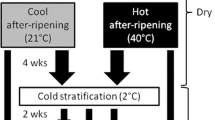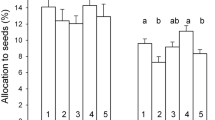Abstract
Reproductive patterns are analysed in annual legumes of west Asia, and their relationships to increasing aridity determined by multivariate analysis. Dormancy, seed size, dispersal and fecundity are shown to be partially substitutable in terms of their effect on survival and population growth.
The range of patterns show greatest diversity under mesic conditions in coastal, mediterranean areas with high winter rainfall, low incidence of frost and long growing season. Increasing aridity leads to increasing reproductive homogeneity, in which a subset of patterns-those composed of high levels of seed dormancy, high seed to pod ratios, restricted dispersal capabilities and early flowering-become predominant. These findings corroborate earlier theoretical and empirical evidence concerning desert annuals.
The majority of widespread species are shown to possess “arid-type” patterns. This exerts considerable influence on both the type and degree of ecotypic differentiation within species. The only feature that responds consistently to climatic change is flowering time, particularly among species characterized by high seed dormancy. In the few widespread species that do not display “arid-type” characteristics, ecotypic differentiation appears more frequently in a larger suite of traits.
The unequal environmental demands made on species showing different levels of dormancy (e.g. variation in length of growing season from year to year and place to place) leads to strong asymmetries governing the relationships between reproduction and ecological amplitude. In this respect “arid-type” strategists with high seed dormancy appear to have greater chances of expansion than others. This has implications when choosing pasture legumes to improve mediterranean grasslands.
Similar content being viewed by others
References
Antonovics, J. & Bradshaw, A.D. 1972. Variation in wild populations of Papaver dubium L. Heredity 25: 91–100.
Baker, H.G. 1972. Seed weight in relation to environmental conditions in California. Ecology 53: 997–1010.
Brown, J.S. & Venable, D.L. 1986. Evolutionary ecology of seed-bank annuals in temporally varying environments. Am. Nat. 127: 31–47.
Carey, K. 1983. Breeding system, genetic variability, and response to selection in Plestries (Valerianaceae). Evolution 37: 947–956.
Carlquist, S. 1967. The biota of long distance dispersal. V. Plant dispersal to Pacific Islands. Bull. Torr. Bot. Club 94: 129–162.
Cavers, P.B. & Harper, J.L. 1966. Germination polymorphism in Rumex crispus and Rumex obtusifolius. J. Ecol. 54: 367–382.
Clausen, J. & Hiesey, W.M. 1958. Experimental studies on the nature of species. 4. Genetic structure of ecological races. Carngie Institute of Washington Publication No. 615.
Cocks, P.S. 1993. Seed and seedling dynamics over four consecutive years from a single seed set of six annual medics (Medicago spp.) in north Syria. Exp. Agric. 29: 461–472.
Cocks, P.S. & Ehrman, T.A.M. 1987. The geographic origin of frost tolerance in Syrian pasture legumes. J. Appl. Ecol. 24: 673–683.
Cohen, D. 1966. Optimizing reproduction in a randomly varying environment. J. Theor. Biol. 12: 119–129.
Cohen, D. 1967. Optimizing reproduction in a randomly varying environment when a correlation may exist between the conditions at the time a choice has to be made and the subsequent outcome. J. Theor. Biol. 16: 1–14.
Cohen, D. 1968. A general model of optimal reproduction in a randomly varying environment. J. Ecol. 56: 219–228.
Cohen, D. 1971. Maximizing final yield when growth is limited by time or by limiting resources. J. Theor. Biol. 33: 299–307.
Cohen, D. 1976. The optimal timing of reproduction. Am. Nat. 110: 801–807.
Comins, H.N., Hamilton, W.D. & May, R.M. 1980. Evolutionarily stable dispersal strategies. J. Theor. Biol. 82: 205–230.
Cook, R. 1980. Biology of seeds in the soil. In: Demography and Evolution in Plant Populations. O., Solbrig (ed.). pp. 107–129. Blackwell Scientific Publications, Oxford.
Davis, P.H. 1973. Flora of Turkey and the East Aegean Islands, Volume 3. University Press, Edinburgh.
Dennett, M.D., Rodgers, J.A. & Keatinge, J.D.H. 1983. Simulation of a rainfall record for a site of a new agricultural development: an example from northern Syria. Agric. Meteorol. 29: 247–258.
Ehrendorfer, F. 1971. Evolution and ecogeographical differentiation in some south-west Asiatic Rubiaceae. In: Plant Life in South-west Asia. P.H., Davis (ed.). University Press, Aberdeen.
Ehrman, T. & Cocks, P.S. 1990. Ecogeography of annual legumes in Syria: distribution patterns. J. Appl. Ecol. 27: 578–591.
Ehrman, T. & Maxted, N. 1989. Ecogeographic survey and collection of Syrian Vicieae and Cicereae (Leguminosae). FAO/IBPGR Plant Gen. Resour. Newsl. 77: 1–8.
Ellner, S. 1986. Germination dimorphisms and parent-offspring conflict in seed germination. J. Theor. Biol. 123: 173–185.
Ellner, S. & Schmida, A. 1981. Why are adaptations for long-range seed dispersal rare in desert plants? Oecologia 51: 133–144.
Engelman, L. & Hartigan, J.A. 1985. K-means clustering. pp. 464–473. In: W.J., Dixon, L., Engelman, J.W., Frane, M.A., Hill, R.I., Jennrich & J.D., Toponek (eds.). BMDP Statistical Software Manual. University of California Press, Berkely.
Evenari, M., Shanan, L. & Tadmor, N. 1971. The Negev: the challenge of a desert. Harvard University Press, Cambridge, Massachusets.
Fenner, M. 1980. Germination tests on thirty-two east African weed species. Weed Res. 20: 135–138.
Freas, K.E. & Kemp, P.R. 1983. Some relationships between environmental reliability and seed dormancy in desert annual plants. J. Ecol. 71: 211–217.
Gross, K.L. 1984. Effects of seed size and growth form on seedling establishment of six monocarpic perennials. J. Ecol. 72: 369–387.
Gutterman, Y. 1981. Influences on seed germinability: phenotypic maternal effects during seed maturation. Israel J. Bot. 29: 105–117.
Hamilton, W.D. & May, R.M. 1977. Dispersal in stable habitats. Nature 269: 578–581.
Harper, J.L. 1977. Population Biology of Plants. Academic Press, London.
Heym, C.C. 1966. Annual species of the genus Medicago. Scripta Hierosolymitana 12. Jerusalem.
Koller, D. 1972. Environmental control of seed germination. In: Seed Biology, Vol. 2. T.T., Kozlowski (ed.). pp. 1–101. Academic Press, New York.
Lesins, K.A. & Lesins, I. 1979. Genus Medicago L. (Leguminosae): a Taxogenetic Study. Junk, The Hague, The Netherlands.
Levin, S., Cohen, D. & Hastings, A. 1984. Dispersal strategies in patchy environments. Theor. Popul. Biol. 26: 165–191.
Lovett Doust, J. 1980. A comparative study of life history and resource allocation in selected Umbelliferae. Biol. J. Linn. Soc. 13: 139–154.
MacArthur, R.H. 1972. Geographical Ecology. Harper & Row, New York.
Marshall, D.R. & Brown, A.H.D. 1983. Theory of forage plant collection. In: Genetic Resources of Forage Plants. J.G., McIvor & R.A., Bray (eds.). pp. 63–81. CSIRO, Melbourne.
Mayer, M. & Polyakoff-Mayber, A. 1975. The Germination of Seeds, 2nd Edition. Pergamon Press, Oxford, UK.
McGinley, M.A., Temme, D.H. & Geber, M.A. 1987. Parental investment in offspring in variable environments: theoretical and empirical considerations. Am. Nat. 130: 370–398.
Ministery of Defence 1977. Climatic Atlas of Syria. Climate Division, Meteorological Department, Syrian Arab Republic, Damascus.
Murfet, I.C. 1977. Environmental interaction and the genetics of flowering. Annul. Rev. Plant Physiol. 28: 253–278.
Philippi, T. & Seger, J. 1989. Hedging one's evolutionary best, revisited. Trends Ecol. Evol. 4: 41–44.
Pijlvan der, L. 1972. Principles of Dispersal in Higher Plants. Springer Verlag, Berlin.
Primack, R.B. 1978. Regulation of seed yield in Plantago. J. Ecol. 66: 835–847.
Primack, R.B. & Antonovics, J. 1982. Experimental ecological genetics in Plantago. 7. Reproductive effort in populations of P. lanceolata L. Evolution 36: 742–752.
Puckridge, D.W. & French, R.J. 1983. The annual legume pasture in cereal-ley farming systems of southern-Australia: a review. Agric. Ecosyst. Environm. 9: 229–295.
Quinlan, J.D. & Preston, A.P. 1968. Effects of thinning blossoms and fruitlets on growth and cropping of sunset apple. J. Hortic. Sc. 43: 373–381.
Rathke, B. & Lacey, E.P. 1985. Phenological patterns of terrestrial plants. Ann. Rev. Ecol. Syst. 16: 179–214.
Ritland, K. 1983. The joint evolution of seed dormancy and time of flowering in annual plants living in a variable environment. Theor. Popul. Biol. 24: 213–243.
Silvertown, J. 1988. The demographic and evolutionary consequences of seed dormancy. In: Plant Population Ecology. A.J., Davey, M.J., Hutchings & A.R., Watkinson (eds.). pp. 205–219. Blackwell Scientific Publications, Oxford.
Small, E. 1981. A numerical analysis of major groupings in Medicago employing traditionally used characters. Can. J. Bot. 59: 1553–1577.
Smith, C.C. & Fretwell, S.D. 1974. The optimal balance between size and number of offspring. Am. Nat. 108: 499–506.
Stebbins, G.L. 1971. Processes of Organic Evolution. Prentice Hall, Englewood Cliffs, New Jersey.
Stephenson, A.G. 1981. Flower and fruit abortion: proximate causes and ultimate functions. Annu. Rev. Ecol. Syst. 12: 253–279.
Taylor, G.B. 1981. Effect of constant temperature treatments followed by fluctuating temperatures on the softening of hard seeds of Trifolium subterraneum L. Aust. J. Plant Physiol. 8: 547–558.
Thompson, K. & Grime, J.P. 1979. Seasonal variation in the seed bank of herbaceous species in ten contrasting habitats. J. Ecol. 67: 893–921.
Thompson, K. & Grime, J.P. 1983. A comparative study of germination responses to diurnally fluctuating tempertures. J. Appl. Ecol. 20: 141–156.
Thomson, E.F., Rihawi, S., Cocks, P.S., Osman, A.E. & Russi, L. 1990. Recovery and germination rates of seed of mediterranean medics and clovers offered to sheep at a single meal or continuously. J. Agric. Sc. Cambridge 114: 295–299.
Venable, D.L. 1985. Ecology of achene dimorphism in Heterotheca latifolia. 3. Consequences of varied water availability. J. Ecol. 73: 757–763.
Venable, D.L. & Brown, J.S. 1988. Selective interactions of dispersal, dormancy and seed size as adaptations for reducing risk in variable environments. Am. Nat. 131: 360–384.
Venable, D.L. & Lawlor, L. 1980. Delayed germination and dispersal in desert annuals: escape in space and time. Oecologia 46: 272–282.
Wickens, G.E. 1976. Speculations on long distance dispersal and the flora of Jebel Marra, Sudan. Kew Bull. 31: 105–150.
Winn, A.A. 1985. Effects of seed size and microsite on seedling emergence of Prunella vulgaris in four habitats. J. Ecol. 73: 831–840.
Woodward, R.G. & Morley, F.H.W. 1974. Variation in Australian and European collections of Trifolium glomeratum L. and the provisional distribution of the species in southern Australia. Aust. J. Agric. Res. 25: 73–78.
Wright, S. 1966. Evolution and the Genetics of Populations. Vol. 1. Genetic and Biometrical Foundations. University of Chicago Press, Chicago.
Zohary, M. 1962. Plant Life of Palestine. Rheinhold Press, London.
Zohary, M. & Heller, D. 1984. The Genus Trifolium. Israel Academy of Sciences and Humanities, Jerusalem.
Author information
Authors and Affiliations
Rights and permissions
About this article
Cite this article
Ehrman, T., Cocks, P.S. Reproductive patterns in annual legume species on an aridity gradient. Vegetatio 122, 47–59 (1996). https://doi.org/10.1007/BF00052815
Accepted:
Issue Date:
DOI: https://doi.org/10.1007/BF00052815




